Rio de Janeiro Travel Guide
Bikinis on the beach, samba in the streets, a stunning mountainous backdrop, and a rainforest within city limits... how many more reasons can there be to book a holiday in Rio de Janeiro, the vibrant heart of Brazil?
Best known for its dazzling annual Carnival, thought to be the biggest party in the world, Rio is a fun, sexy city irresistible to party-goers. All year round, the Rio nightlife is lively, so those missing Carnival needn't worry that they won't experience the legendary energy of the city. Of course, a holiday in Rio de Janeiro is also perfect for sun-lovers, with 62 miles (100km) of beaches flanking the city. Travellers will find a booming restaurant scene and a rich and varied culture in Rio de Janeiro, with museums and galleries enough to please any committed sightseer, not to mention iconic urban landmarks.
Best time to visit Rio de Janeiro
With holiday beach weather the order of the day almost every day of the year, there is never a bad time to visit Rio de Janeiro. Those in search of a party are particularly attracted to travel to Rio for Carnival, held annually in January or February, when the samba schools parade through the streets in their brilliant costumes. Travellers should note that the peak summer months (December to February) can be very hot and humid in Rio. Read more on Rio de Janeiro's Climate and Weather.
What to see in Rio de Janeiro
-Stand with the iconic Christ the Redeemer statue and take in the city below.
-Catch a soccer game at the celebrated Estadio do Maracana.
-Enjoy Ipanema's glorious beaches and feisty nightlife.
-Explore Santa Teresa, a charming, maze-like, old district.
What to do in Rio de Janeiro
-Shop and sunbathe in the famous coastal neighbourhood of Copacabana.
-Tour one of the colourful favelas, like Rocinha, for a taste of how the locals live.
-Ride the cable car up Sugar Loaf for the best views of the city.
-Make an excursion to the many islands of Angra dos Reis.
Beyond Rio de Janeiro
As the city is blessed with rainforests and gorgeous beaches, as well as diverse urban attractions, it is easy to spend a whole holiday in Rio de Janeiro, but those wanting to explore farther afield will find that the nearby Buzios Peninsula is filled with some very popular beach resorts. Though farther away, the Iguacu Falls of southern Brazil are also a popular excursion from Rio.
Getting there
Galeao Antonio Carlos Jobim International Airport, commonly known as Galeao International Airport, is one of the busiest airports in Brazil and underwent significant improvements for the 2014 World Cup. The airport is located 13 miles (20km) from downtown Rio de Janeiro. Get more information on Airports in Rio de Janeiro.
Did you know?
-Christ the Redeemer has been named one of the seven wonders of the modern world.
-At least 20 percent of Rio de Janeiro's population live in the poverty-stricken favelas.
-Rio has more than 46 miles (74km) of bicycle trails, mostly along the beaches.
Things to do in Rio de Janeiro
Steeped in rich and diverse cultural history, and home to a marvellous variety of spectacular attractions, Rio de Janeiro is a sightseer's dream. Plus, with miles of beautiful coastline and some seriously exciting neighbourhoods to explore, this city has much to offer its visitors.
A visit to Rio de Janeiro would not be complete without the obligatory visits to Sugar Loaf Mountain and the statue of Christ the Redeemer â€' one of the New7Wonders of the World and Rio de Janeiro's most famous landmark. Ipanema is the place to go for sun worshippers, where miles of white beaches await and shopping opportunities abound.
We highly recommend exploring the cobblestone streets of downtown Centro, Lapa and Santa Teresa, and, when the sun starts dipping below the horizon, sipping on caipirinha cocktails and singing along to the hit Barry Manilow tune in Copacabana.
Sports lovers should head down to the Estádio do Maracanã to take in a soccer match, although they should know that the atmosphere can be fierce and extremely charged.
We'd advise that those tourists planning on a prolonged visit research different pass packages for Rio de Janeiro. These might help curb the admission prices of the various tourist attractions and help save on public transport costs. Travellers should check out all available options to find a package that suits them best.
Corcovado
The iconic statue of Christ the Redeemer, arms spread to welcome the world, is the world-famous symbol of Rio de Janeiro. It stands atop a mountain 2,330 feet (710m) above the beaches below, and is accessed via a miniature train that runs from the Cosme Velho District through the Atlantic rainforest to the foot of the statue. The train ride offers stunning vistas of Rio, and the view from the summit is simply breathtaking. Spread out beneath the statue is the Tijuca Forest, an enchanting world of natural pools and waterfalls. Beneath the cooling canopy are attractions such as the Mayrink Chapel, which features murals painted by famous Brazillian artist Candido Portinari, and the Museu do Acude, which houses colonial furniture and an impressive collection of china.
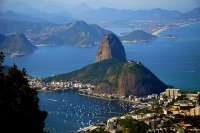
Sugar Loaf
An iconic fixture of the Rio skyline, Sugarloaf Mountain is known worldwide for its sweeping views of the city below. The summit of the 1,299 foot high (396m) belvedere can be reached by a two-stage cable car ride. The first stage takes visitors up 722 feet (220m) to the Morro da Urca, where there is a restaurant, amphitheatre and spectacular view of the Yacht Club and Botafogo Bay. The second stage ascends to the summit for a panoramic view of the city, and the whole of Copacabana beach. The Sugar Loaf cable car is a major icon of Rio's tourism and a must for first-time visitors to the city.
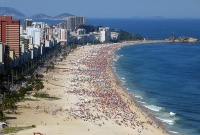
Ipanema
Immortalised in song, this Rio neighbourhood offers a legendary beach, excellent hotels, a bustling nightlife, sophisticated shopping and quality restaurants, all within walking distance of each other. Ipanema is famous for setting fashion trends, particularly in the line of swimwear, and fashion followers should look out for the famous bikini boutiques such as Salinas, Blue Man and Bum-Bum. The Rua Garcia D'Avila is perfect for designer fashion, jewellery and furniture, while the nearby Amsterdam Sauer Museum of Gems has an interesting tour of its workshop. There are plenty of other popular shopping strips here, including the eclectic commercial street Visconde de Piraja, lined with speciality shops, boutiques and restaurants, as well as the bohemian fair at General Osorio Square on Sundays, with its collection of wooden sculptures, exotic musical instruments and artworks.

Copacabana
This famous Rio beach neighbourhood was just a small fishing village until a new highway built in the early 1900s brought crowds of visitors to its golden shores. The Copacabana Palace Hotel first opened its doors in 1923 and heralded the construction of scores of Neoclassical and Art Nouveau skyscrapers, penthouses and apartments in the area. Visitors still flock to the hotel, which is the place to be seen, especially at the famed Cipriani restaurant. The white sands and calm waters of the beach make for an idyllic setting and is also a popular spot for beach soccer, volleyball and sunbathing. Copacabana beach is particularly popular on New Year's Day, when beachgoers dress in white and celebrate in droves, with more than 2 million people crowding the beach.
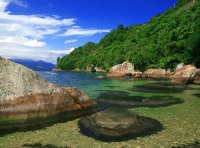
Angra dos Reis
This peninsula and group of islands is a holiday playground containing 2,000 beautiful beaches and a wonderland of mountains, forests, waterfalls, lakes and secret coves. Visitors can take trips by schooner or yacht to explore the delights of the area: fishing and scuba diving are the favoured activities for tourists among various other water sports, while on land there are hundreds of walking trails giving access to some of the less frequented beaches such as Canto, Abraãozinho, Morcego and Grande das Palmas. The beaches of Aventureiro and Lopes Mendes are popular surf spots. The islands can easily be reached from Rio by road in just over three hours, or accessed by bus with daily departures every hour from the Novo Rio Bus Station.
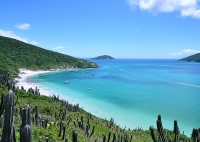
Buzios Peninsula
Once the preserve of pirates and slavers, the Buzios Peninsula is today the haunt of the rich and famous who flock here to enjoy the dozens of inviting beaches. Situated 109 miles (176km) northeast of Rio de Janeiro, Buzios Peninsula is a sophisticated beach resort with a buzzing nightlife and a selection of fine restaurants. The west coast beaches offer calm, clear waters ideal for swimming, while the east coast beaches face the open sea and are a little wilder, drawing surfers and water sports enthusiasts to its choppy waters. Among the most popular beaches are Azeda Beach, João Fernandinho Beach, Ferradura Beach and Geriba beach, which is particularly popular with surfers.

Iguaçu Falls
The Rio Iguaçu begins its journey in the coastal mountains of Paraná and Santa Catarina, snaking west for 370 miles (600km) before it widens and then plunges through the jungle in tiered falls at the border with Argentina and Paraguay.
The Foz do Iguaçu (Iguaçu Falls) are more than two miles (3km) wide and 262ft (80m) high (almost twice the height of Niagara Falls), and their beauty is unmatched. Almost twice the height of Niagara Falls, their name fittingly comes from the Guarani Indian word meaning 'great waters'. The deep flowing waters of the river tumble down 275 falls, the most famous of which is Devil's Throat on the Argentinian border, with a drop of 230ft (70m).
As well as taking in the stunning views, visitors can enjoy kayaking and other water sports in the river. The best time of year to visit is August to November, when there is least risk of floodwaters hindering the approach to the boardwalks. The falls are surrounded by the Iguaçu National Park, a huge sub-tropical rainforest covering 135,000 acres and home to thousands of different species of animals and birds, including flamboyant parrots and pretty hummingbirds.

Estádio do Maracanã
Even for non-football fans, São Paulo's Museu do Futebol is a must-see. The Brazilian team has unquestionably been the sport's most successful and exciting national football team, and the Seleção (the Brazillian national team) is worshipped with a religious fervour. Housed within the city's iconic Pacaembu Stadium, the museum takes a modern, interactive approach to its exhibitions, with holographic displays, touch-screen information panels and various other multimedia installations. Highlights of the museum include the 'History of the World Cup' section, and a display introducing Brazil's 25 greatest-ever players. An appreciation of what football means to the country is vital to getting to grips with Brazilian culture, and São Paulo's Football Museum is a wonderful and appropriate introduction.
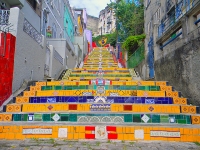
Santa Teresa
Having had their fill of the beach, tourists who want to experience 'the real Rio de Janeiro' should make a beeline for one of its most iconic neighbourhoods, Santa Teresa. Located at the top of Santa Teresa Hill, the neighbourhood is famous for its winding, narrow streets, 19th century architecture and sublime array of restaurants, bars, art galleries and eclectic shops. A popular area for local artists and tourists alike, Santa Teresa is best reached using its historic tram service, which departs from Largo da Carioca square and runs up the hill. The only one of its kind in Rio, it wends through Santa Teresa's picturesque streets, offering magnificent views of the city below.
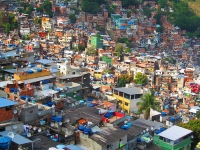
Rocinha
A tour through the sprawling urban township (favela) of Rocinha caters to those who wish to get to grips with the social reality facing most Brazilians in Rio de Janeiro. Thankfully, tours with local guide Zezinho aren't voyeuristic or intrusive as they are conducted with a great love for and desire to share their culture with foreigners. All who take part in his tour of Rocinha agree that it's a valuable, moving and humanising experience. There are also other guides and companies offering good tours of the various favelas and it's important to book in advance.
Eating Out
Brazilian cuisine is famous for its use of red meat, a fact deliciously confirmed when eating out in Rio. Churrascarias (Brazilian barbeque) is a simple beef dish, normally spiced only with salt, and often accompanied with feijão com arroz (rice and beans). Other meat may end up in feijoada, a traditional stew made with black beans. Local taste runs toward oily, sweet and salty food, with a noticeable lack of spices. A popular treat is bacalhau (salted cod), which is usually imported from Norway. Good restaurants in which to look for traditional Brazilian food include Bar do Arnaudo in Santa Teresa and Brasileirinho in Ipanema.
Lunch in Rio is an adventure for those on a budget. A range of street vendors means visitors can indulge in anything from fruit and cheese bread to succulent prawns. The beach has many similar options, including oysters or shrimp tarts, and exotic drinks such as fresh coconut water out of the shell and bright purple açai juice. Bob's Burgers is a big fast food franchise which will take orders and deliver to customers right on the beach.
One popular type of Rio restaurant offers a pay-by-weight system where the customer selects food from a buffet, bringing it to the chef to be cooked. This is a great way to sample a variety of different dishes, taking as much or as little as you like, while the waiters mark your receipt. Take care to keep your receipt safe, though, as the fee for losing it is often very high. Frontera in Ipanema is a good example of this type of establishment, as is Fellini in Leblon.
Most restaurants in Rio de Janeiro are open from 11am to 4pm, and from 7pm to midnight. Some stay open all day, especially on Saturdays when people stream in from the beaches at all hours. Restaurants usually add a 10 percent service charge to the bill, but waiters will appreciate another five percent if their service has been good.
Shopping
Shopping in Rio de Janeiro can be a rewarding experience for tourists on the hunt for bargains, whether they seek cheap souvenirs or designer goods. While Rio is not usually considered a major shopping destination, there are a number of shopping centres, boutiques, street stalls and markets offering a wide selection of mementos. The main shopping destinations are concentrated in areas such as Rio Sul in the city centre, but there are also several shopping districts near the beaches, including Avenida Nossa Senhora and Rua Barata Ribeiro in Copacabana, Avenida Ataulfo de Paiva in Leblon, and Rua Visconde de Pirajá in Ipanema.
Religious antiques, soapstone carvings, leather goods and gemstone jewellery are Rio's most popular souvenirs, vended by various establishments throughout the city. You can also find local gemstones carved into anything from a tiny Christ the Redeemer to shapes of toucans, jaguars and other wild figures that make for great mementos.
Good-quality beachwear and Brazilian soccer jerseys are popular, though you'll need to choose between cheap imitations at market stalls and more expensive official merchandise, typically sold at stadium shops. Rio is also the birthplace of Havaianas (flip-flops), which you'll find here in any number of styles and colours. A classic souvenir that captures the essence of Rio is music, particularly Brazil's distinctive local music. For a good selection of jazz music and books, head to the artsy Livraria da Travessa.
The gift shop at the Museu do Índio has a selection of pots, woven baskets and wooden artefacts made by indigenous tribes. Another unique keepsake is a bottle of cachaça, or sugar cane brandy, which is the most popular spirit in Brazil and brewed at Petisco da Vila. Try a sample after watching the production process at the brewery.
Good-quality local arts and crafts can be found at outdoor weekend markets, the best of which include the Hippie Fair, the Babilônia Hype Fair and the enormous Feira Nordestina São Cristóvão, which has more than 700 stalls. For flowers and food, including fruit, vegetables and cheeses, Praca General Osorio in Ipanema and Rua Domingos Ferreira in Copacabana are worth a visit.
Most items are reasonably priced, as long as you stay away from the obvious tourist traps around the major hotels. Bartering is acceptable, and visitors can often earn up to a 10 percent discount in shops if paying cash, though most shops and even some markets will accept major credit cards. Shops tend to stay open Monday to Friday from 9am to 7pm, and shopping centres stay open daily from 10am to 10pm. Sales tax is 18 percent, and there is no tax refund scheme for departing tourists in Brazil.
Nightlife
Home to Carnival, samba and Copacabana, it's not surprising that the nightlife in Rio de Janeiro is one of a kind, and Cariocas (Rio's residents) don't need much excuse to party. Whether visitors are looking for a relaxing bar or lounge to sip on a couple of chopps (draught beer), or in the mood for a night of dancing, Rio's got it covered.
A popular way to warm things up is to start at one of the scores of beach bars with a coconut juice or cocktail in the cooler early evening. Head off to one of Rio de Janeiro's trendy beach communities, such as Copacabana, Ipanema or Leblon and explore the bars and clubs. But be warned, some of these places may not grant entry to people wearing shorts, t-shirts or flip-flops.
The clubs generally start to really heat up around midnight, so most visitors enjoy a late dinner at one of Rio's many trendy eateries or botequins (traditional Brazilian bar) before checking out the club scene at the Rio Scenarium, Comuna da Semente or Carioca da Gema. Lapa is a popular area for revellers, as is Gamba. Rio also has a vibrant gay party scene, with many bars and clubs in Copacabana and Ipanema.
Clubbing in Rio can be expensive, but a cheaper night out is possible by sticking to local beverages. Many establishments will charge patrons for drinks and entry only when they leave, so it's wise to keep track of what one spends. Most clubs have a dress code and some will only allow men when accompanied by women, while most will require an ID or passport to enter.
An alternative to clubs and bars in Rio are its famous street parties. Lapa hosts a street party every Friday and Saturday night near the aqueduct on Avenida Mem de Sá, while Sundays, Mondays and Thursdays are the best nights to head to Gávea, where you'll find music, cheap beer and many university students on the street in front of the bar Hipódromo.
Live music and dancing is an integral part of Rio culture, boasting a veritable treasure trove of samba, bossa nova, rock, MBP (Brazilian pop), blues and jazz. There's seemingly always a gig going down on any given night in Rio. A popular option is watching samba school rehearsal parties, where local drummers and dancers showcase their skills in warehouses for thousands of people. It's a great way to get a taste of the Carnival atmosphere at other times of the year.
Getting Around
Driving in Rio is not recommended for overseas visitors due to the chaotic nature of the city's traffic. But driving is usually not necessary anyway, as the public transport system in Rio is cheap and efficient, and most places can be reached by metro or bus. By far the quickest and easiest way to get around is by the efficient metro; it does have its limits though, as it only runs two lines. Walking around is generally safe as long as there are crowds of people, although walking in the centre of the city is not recommended after the shops close and security guards go home.
The most inexpensive form of transport is the local buses, which travel all over the city as fast as the traffic will allow. Buses are privately operated, so services and costs will vary. Unfortunately, they are often badly driven, crowded, and often the scene of petty theft. Special care should be taken on buses known to be used by tourists, such as those that run to the popular Sugarloaf Mountain.
Most public transport stops around midnight, with some buses operating 24 hours a day but, for safety's sake, we'd rather recommend hiring a taxi late at night. Radio taxis can be ordered and are said to be safer and more reliable, usually with air-conditioning, but they are more expensive than regular taxis and drivers may add a surcharge for extra luggage. Most taxi drivers speak only Portuguese, so visitors should have their destination written down. Ride-sharing apps such as Uber and Lyft are available, and circumvent language barriers, routes and fare uncertainties.
Rio de Janeiro Climate and Weather
Situated in the tropical South Atlantic, Rio de Janeiro is warm all year round. Summers (December to February) are very hot and humid with heavy rains. Temperatures during the summer months frequently rise as high as 104°F (40°C). Winters (June to August) are cool and dry with lows around 64°F (18°C), never cold, with some precipitation.
Brazil travel info
Electricity
Brazil has a variety of electrical voltages, sometimes within the same city. The better hotels offer 220 volts, 60Hz. If not, transformers are available in electrical stores. Two-pin plugs with a grounding pin are standard.
Language
The spoken language in Brazil is Portuguese, however Spanish and English are also used in the cities.
Money
The Brazilian currency is the Real (BRL). The US Dollar is also welcome in most tourist establishments. In the main cities, foreign currencies can be exchanged at banks or cambios. There is an extensive network of ATMs in the country and most major international credit cards are accepted.
Tipping
Nearly all hotels add a service charge to the bill, usually 10 percent. Most restaurants also add 10 percent or more to the total of the bill, but must make it clear that they have done so; waiters appreciate another five percent if their service was good. Otherwise, a 10 to 15 percent tip is customary.
Brazilians don't normally tip taxi drivers, except if they handle bags, although they may round up the total. Hotel staff expect small tips, and most other service personnel such as barbers and petrol station attendants, are usually rewarded with a 10 to 15 percent tip. Parking attendants earn no wages and expect a tip of around two real.
Health
Mosquito-borne diseases like dengue fever and malaria are prevalent in Brazil, so insect repellent and protective clothing is essential if visitors will be travelling to the countryside. Malaria exists below 2,953 feet (900m) in most rural areas, and outbreaks of dengue fever occur frequently.
Visitors travelling from infected areas outside the country require a yellow fever certificate, and vaccination is recommended for those travelling to rural areas, as outbreaks have occurred in recent years.
Typhoid vaccinations are recommended if travellers intend to spend a lot of time outside of major cities. Milk in rural areas is not pasteurised, so it's best to avoid it. Hospitals in the major cities are fairly good, with cash and card payments both acceptable and travel insurance common.
Safety
In Brazil's metropolitan areas, crime is a fact of life. Rio, in particular, is regarded as one of the most crime-ridden cities in the world and, although violent crime is generally limited to the favelas, foreigners are advised to take precautions. Visitors should not attempt to visit these township areas, even on a guided tour. Violent crime is on the increase due to the establishment of drug and criminal gangs around Rio and São Paulo.
Muggings are frequent and visitors should dress down, conceal cameras and avoid wearing jewellery or expensive watches. Bank- and credit card fraud is common, including card cloning from ATMs, so tourists should keep sight of their card at all times and not use an ATM if they notice anything suspicious.
Thefts are common on public beaches and visitors should avoid taking valuables to the beach. The threat of personal attack is lower outside the main urban centres, but incidents do occur. Women should be aware that sexual assaults have been reported in coastal holiday destinations. Beware of unofficial taxis and those with blacked-out windows, and be particularly careful on public transport in Rio, Recife and Salvador.
Local customs
Brazil is a diverse cultural and ethnic melting pot, but most social customs will be familiar to visitors. As a result of three centuries of colonisation by the Portuguese, the Brazilian culture is actually recognisably European in many ways. Physical appearance is considered important by most Brazilians and care is taken to dress well but generally not too formally.
Doing business
Business practices vary quite substantially from city to city in Brazil: highly formal in São Paulo but more relaxed in Rio de Janeiro and other centres. Multinational companies have similar business etiquette to those in Europe or the US, while local businesses require a few more considerations, particularly preferring face-to-face meetings over phone calls or written communication.
Brazilians place a high value on personal relationships within business environments and will generally only conduct business through personal connections or with those whom they have already established a personal relationship. Nepotism is considered not only acceptable but actually desirable, because it is seen as ensuring trust and good relationships in business.
All meetings are preceded by handshakes and small talk, and visitors should avoid the temptation to rush things. Even after the meeting is over, it's considered rude to rush off. Entertaining is common, either at a restaurant or someone's home, again with the emphasis on building personal relationships. Punctuality is flexible, except when meeting at a restaurant, when tardiness is considered impolite, and a small gift or flowers for the host is common when invited to a home.
Business suits are expected, especially for first meetings. Portuguese is the dominant language, and although English is widely spoken in business, an interpreter might be required. Business cards, as well as written documents, should be printed in both English and Portuguese. Business hours are 8.30am to 5.30pm Monday to Friday.
Duty free
Travellers to Brazil can enter the country with 200 cigarettes or 25 cigars; 24 units of alcoholic beverages, with a maximum of 12 units per type of beverage; and goods to the value of USD 500, without incurring customs duty. Restricted items include fresh produce, meat and dairy products. Strict regulations apply to temporary import or export of firearms, antiquities, tropical plants, medication and business equipment.
Communications
The international access code for Brazil is +55. Hotels, cafes and restaurants offering free WiFi are widely available in tourist centred areas. As international roaming costs can be high, purchasing a local prepaid SIM card can be a cheaper option.
Passport & Visa
All visitors require passports that are valid for at least the period of intended stay in Brazil but we strongly recommend that passports be valid for six months after intended date of travel. Border control may well deny entry to holders of passports valid for the period of intended stay. Sufficient funds to cover their stay in Brazil, as well as a return or onward ticket and documentation required for further travel, are necessary for all travellers. Visa requirements vary from country to country.
Entry requirements
US passports must be valid for the duration of stay. Tourists can stay in the country without a visa for up to 90 days.
UK passports must be valid for at least six months after the date of arrival. UK passport holders do not require a visa for stays of up to 90 days.
Canadian passports must be valid for six months beyond the departure date. Tourists can stay in the country without a visa for up to 90 days.
Australian passports must be valid for six months beyond the date of entry. Tourists can stay in the country without a visa for up to 90 days.
South African nationals need a passport that is valid for the duration of their stay, but do not require a visa for up to 90 days.
Irish nationals need a passport that is valid for the duration of their stay, but do not require a visa for stays of up to 90 days.
New Zealanders need a passport that is valid for the duration of their stay, but do not require a visa for up to 90 days.
Useful contacts
Brazilian Tourist Institute, Brasília: +61 429 7704 or presedencia@embratur.org.br
Emergencies: 190 (police), 192 (ambulance)


